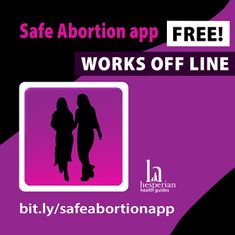Hesperian Health Guides
Complications of Abortion
Fast treatment of abortion complications prevents illness, infertility, and death. Seek help quickly if you have problems after an abortion. DO NOT WAIT
Contents
Heavy bleeding from the vagina
Heavy bleeding is the most common problem after an abortion. It is usually caused by pieces of the pregnancy that are left in the womb. The womb cannot squeeze itself shut and keeps bleeding. This is called an incomplete abortion. If the pieces are removed, often the bleeding will stop. Sometimes the bleeding is caused by a torn cervix which must be stitched for the bleeding to stop.

Someone is bleeding too much if they:
- soak more than 2 maxi pads or cloths in an hour for 2 hours in a row.
- have bleeding with dizziness.
- pass clots larger than an orange.
When this happens, the person may quickly lose a dangerous amount of blood. If it is not possible to get medical help immediately, try to stop the bleeding.

To stop the bleeding
A person who is bleeding too much may be able to to use strong massage to help squeeze their womb shut. They can do this for themself or someone else can do it. Rub or squeeze the lower belly very hard, like you are trying to make the womb smaller, while lying down or squatting.
Even if massage seems to work, get medical help as soon as possible. The person will need antibiotics and may still need to have their womb emptied completely.
Emergency help for too much bleeding
If heavy bleeding is caused by pieces of pregnancy inside the womb, health workers and others trained in giving pelvic exams may be able to follow these steps to try and stop the bleeding until the womb can be emptied.

- Wash your hands and the person‘s genitals with soap and clean water.
- Put a clean latex or plastic glove or a very clean plastic bag on one hand. The gloved hand should not touch anything before it goes into the vagina
- Have the person lie on their back with feet and knees apart. Help them relax.
- If you have a sterile speculum (you can get the right instruments from an IUD kit if you have one), put it into the vagina so you can see the opening of the womb. If you can see tissue or clots or lumps of blood there, try to get hold of them with sterile forceps or clamps and gently remove them.
- If you do not have a speculum, reach inside the vagina with your gloved hand, first with 1 finger, and then with 2 fingers.
- Feel for the cervix. It will feel more firm and smooth than the skin around it. It looks like this and is about the size of 2 fingertips.
- Move your finger across the opening and feel for bits of the abortion that may be sticking out of the opening. They will feel like soft meat. Gently try to remove them. If the pieces are too slippery, take your hand out and wrap 2 fingers with sterile gauze, or a clean cloth that has been boiled in water, and try again to remove them.
- After you have removed the pieces, put your gloved hand into the vagina with 2 fingers under the womb. With your other hand, rub or massage the belly to help stop the bleeding. The womb should be between your 2 hands.
- Have the person dissolve 800 micrograms misoprostol under their tongue for 30 minutes, then swallow what is left. If the person cannot swallow, insert the pills in their rectum. Wear a glove while inserting the pills.
- Give antibiotics immediately to prevent infection. There is a high risk of infection because the womb is open to germs.
- If the person is awake, give them fluids to drink. If the person is unconscious, see below.
- Take the person to a hospital right away, even if you think you have removed the tissue and the bleeding has stopped. The womb still needs to be emptied completely. If the bleeding does not stop, continue to rub or massage the lower belly on the way to the hospital.

|

 |
| Use sterile forceps to remove any tissue you see at the opening of the womb. |
 |
 the cervix, opening of the womb |

|

|
TRANSPORT!
Shock
Shock is a life-threatening condition that can result from heavy bleeding. Bleeding inside the body can also cause shock.TRANSPORT!
DANGER! Heavy bleeding can cause SHOCK, which can kill. Transport immediately.
Signs:
- very fast heart rate, more than 100 beats a minute for an adult
- pale, cold, damp skin
- pale inner eyelids, mouth, and palms
- fast breathing, more than 30 breaths a minute
- confusion or unconsciousness (fainting)
Treatment if the person is conscious:
- Lay the woman down with her feet higher than her head.
- Cover her with a blanket or clothes.
- If she can drink, give her sips of water or rehydration drink.
- Help her to stay calm.
- If you know how, start a fast intravenous drip (IV) with a wide needle, or start rectal fluids.
Treatment if the person is unconscious:
- Lay them on their side, head low and tilted back to the side.

- If they are choking, pull their tongue forward with your finger.
- If they vomit, clean out their mouth immediately. Keep the head low and tilted back to one side so no vomit is breathed into the lungs.
- Do not give anything by mouth until they have been awake for one hour.
- If you know how, start a fast intravenous drip (IV) with a wide needle, or start rectal fluids.
TRANSPORT!
Do not wait for a health worker. Take the person to medical help or to a hospital right away. They need medical help fast!
Infection
Infection after a safe abortion is rare but very serious. It can injure the womb and can spread into the blood (sepsis). Sepsis is very dangerous and can quickly cause shock or death.
Most infections after abortion happen because:
- an unsterile tool was used in the abortion.
- pieces of the pregnancy remain inside the womb.
- the womb was injured during the abortion.
It is also possible the person already had an infection and it got worse after the abortion.

Signs of infection after abortion
- Fever above 38°C (100.4°F)
Note: Taking misoprostol can cause fever, so after an abortion with pills, fever is a danger sign only after 24 hours have passed since taking the medicine.
- Chills and shivering
- Fast heartbeat, over 100 beats a minute
- Swollen, hard, or painful belly
- Bad-smelling, green, or yellow fluid coming from the vagina
To help someone with an infection
- If there is still tissue in the womb, the infection will not get better until it is removed.
- Give antibiotics (see below).
- Give fluids and nutritious foods to help the body fight infection. If the person can drink, give rehydration drink. If they cannot drink, give rectal fluids.
- See how to prevent tetanus infection.
TRANSPORT!

Treatment for infection after abortion:
- Get medical help right away. Give medicines on the way (see below). More than one medicine is used because infections after abortion can be caused by several different germs.
- If these medicines are not available, see the “Medicines Pages” for others that will work. For someone who is breastfeeding, use the first treatment for womb infection.
Medicines for infection after abortion
| Treatment: | ||
| Give one of these combinations of 3 medicines (give all 3 medicines): | ||
| Give all 3 medicines | ||
| ceftriaxone | 250 mg injection into muscle (IM) | 1 time only |
| and | ||
| doxycycline | 100 mg by mouth | 2 times a day |
| (avoid taking doxycycline if you are breastfeeding) | ||
| and | ||
| metronidazole | 500 mg by mouth or by IV | 3 times a day |
| OR | ||
|---|---|---|
| ampicillin | 2 g (2000 mg) IV or IM the first time only, then 1 g (1000 mg) IV or IM each other time | 4 times a day |
| and | ||
| gentamicin | 80 mg IV or IM | 3 times a day |
| and | ||
| metronidazole | 500 mg by mouth or IV | 3 times a day |
| OR | ||
| Give these 2 medicines | ||
| clindamycin | 900 mg IV | 3 times a day |
| and | ||
| gentamicin | 80 mg IV or IM | 3 times a day |
IMPORTANT! If there is no improvement within 24 hours of starting the first medicines, go to a hospital right away | ||
| Stop giving medicines by injection or IV when the signs of infection have been gone for 48 hours. Then start giving medicines by mouth with plenty of water. | ||
| When signs have been gone for 48 hours | ||
| Give 2 medicines: | ||
| doxycycline | 100 mg by mouth | 2 times a day for 10 days |
| (avoid taking doxycycline if you are breastfeeding) | ||
| and | ||
| metronidazole | 500 mg by mouth | 3 times a day for 10 days |
Injury inside the body (internal injury)
An internal injury from an abortion is most often caused by a sharp object that makes a hole in the womb. The object may also cause damage to other internal organs, such as the tubes, ovaries, intestines, and bladder.
Someone with an internal injury may have severe bleeding inside their body but almost no bleeding from their vagina.
Signs (some or all of these):

|
| Listen for gurgles for 2 minutes. |
- the belly feels stiff and hard with no sounds or gurgles inside
- very bad belly pain or cramps
- fever
- nausea and vomiting
- pain in one or both shoulders
Treatment:
TRANSPORT!
- Immediately take the person to a hospital or clinic for surgery. An injury inside the body must be repaired right away by a surgeon or it can lead to infection, shock, and death.
- Do not give anything by mouth—no food, no drink, not even water—unless it will take more than 12 hours to get to a health center. Then give water only in small sips. Or have the person suck on a piece of cloth soaked in water.
- If there are signs of shock, give treatment. Make sure nothing blocks the mouth and that the person is breathing.
- Give the medicines for infection. If possible, give a tetanus toxoid vaccination.
Emotional support after a pregnancy ends

A woman may have strong feelings after an abortion, even if she knows she made the right Some people have strong feelings after an abortion, even when they are sure they made the right decision for themselves and their family. While most people feel relief that the pregnancy ended, some have a mixture of feelings, such as both relief and sadness, or regret, anxiety, guilt, numbness, or even love. It is also common for some people to feel sad and grieve. These feelings are normal, but having to hide them or feel them without any support can make them worse.
Having health problems can also make this time difficult, especially if the problems resulted from not getting good care. An abortion provider who did not do a safe abortion also may have been disrespectful or unkind. The abortion may have been very painful or frightening. When abortion is illegal, people may be afraid of being punished.
Many people find it helpful to talk with a close friend or others who have had a similar experience. Creating rituals to reflect on what happened may help people let go of the experience and move on with life. For example, burying or burning an object related to the abortion can symbolize closure. In some communities, a person may plant a tree or visit a sacred place and make offerings.
Sources
- UpToDate (2022) Retained products of conception in the first half of pregnancy
- World Health Organization (2022) Abortion care guideline
- Harvard Health Publishing (2017) Emergencies and First Aid - Recovery Position
- National Health Service (2022) Recovery position
- Society of Family Planning (2010) Prevention of infection after induced abortion
- UCSF TEACH (2022) Early abortion training curriculum






